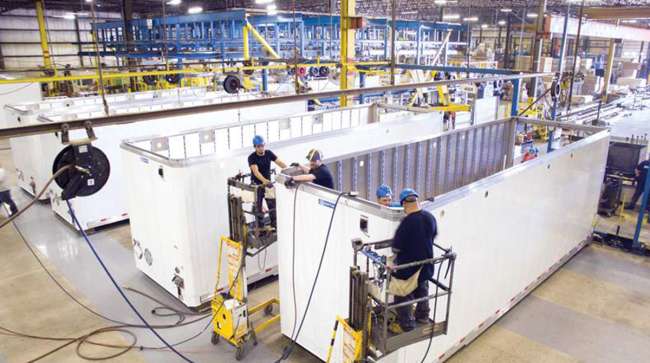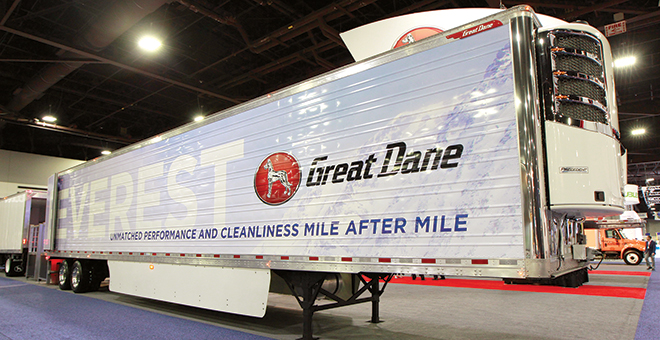September Trailer Orders Improve 76% Year-Over-Year

Strength in dry vans pushed U.S. trailer orders in September to near 23,000, up 76% from a year earlier, ACT Research reported.
Preliminary net orders were 22,900 compared with 12,993 a year earlier, according to ACT, citing data it would update by the end of the month.
All segments posted “solid gains” while dry vans provided “the majority of support,” Frank Maly, ACT director of commercial vehicle transportation and research, said in a statement.
“Our sales were good for vans and chassis but a little soft on reefers,” Hyundai Translead Chief Sales Officer Glenn Harney told Transport Topics.

John Sommers II for Transport Topics
At Great Dane, Vice President of National Accounts David Gilliland said, “Steady new orders are being placed for 2018. Dry vans, reefers and flats are all being ordered.”
Stoughton Trailers Vice President of Sales David Giesen said, “September is a transition month from light ordering to heavy. In recent history it has become a stronger month for order intake and begins the backlog-building season.
“It feels like mostly replacement, but there is some growth mixed in.”
Research company FTR pegged orders at 21,500 and noted the expected volume supports the company’s forecast of another strong trailer market in 2018 with North American production nudging up to 285,000 units compared with an expected 281,000 in 2017.

Ake
“We’ve had three strong years in a row, and we are looking for our fourth next year,” said Don Ake, FTR vice president of commercial vehicles.
Meanwhile, trailer makers’ role in reducing emissions and increasing fuel efficiency under Section IV of the Phase 2 greenhouse gas rule remains an issue before the U.S. Court of Appeals for the District of Columbia Circuit.
Earlier this month, the Environmental Defense Fund and other environmental advocates asked the court to reject the Truck Trailer Manufacturers Association’s bid to stay the rule’s implementation as it pertains to trailers, calling TTMA’s effort an unwarranted “eleventh-hour” maneuver.
That motion on TTMA’s part in September was prompted by the Environmental Protection Agency’s announcement in August it would “revisit” Section IV — with no further details provided as of mid-October.
Initially, TTMA had asked the court in December to vacate the portion of GHG Phase 2 that would allow EPA for the first time to regulate trailer makers under the Clean Air Act. The National Highway Traffic Safety Administration co-authored the Phase 2 rule.
The court in May placed that motion in abeyance, where it remains.
At the same time, Hyundai Translead, Great Dane and Stoughton are preparing to meet the initial requirements of the rule, they said separately.
Other trailer makers were contacted for this article but did not respond.
The first target for increased fuel efficiency in trailers of 2% “is pretty minuscule,” said Glen Kedzie, energy and environmental counsel at American Trucking Associations.
Phase 2 for trailers is scheduled to roll out in four stages: 2018, 2021, 2024 and 2027.
The 2018 portion mandates aerodynamic fairings on large dry and refrigerated vans.
The rule also requires low-rolling-resistance tires and automatic tire-inflation or tire-monitoring systems for all trailers.
“We are moving ahead with the assumption the regulation will take effect on Jan. 1,” Harney said.
Gilliland agreed. “As of today, we have to plan on GHG Phase 2 being in place Jan. 1. With that, we are spec’ing and building trailers that are compliant for deliveries in 2018. If something changes with GHG Phase 2, we will address it at that time.”
Giesen said, “Customers would like to get clarity on Phase 2 and whether this ruling will be changed. In the meantime, we will all have to comply.”




